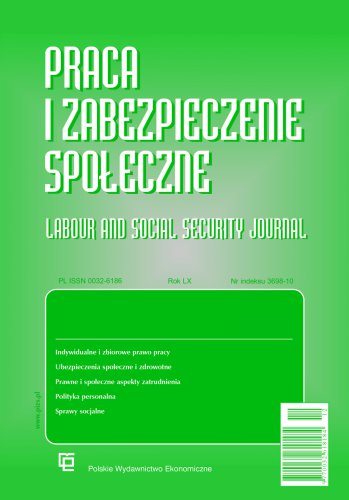The concept of partial sick leave and activation of the insured on the example of selected European countries and the Polish sickness insurance system
A number of reforms relating to incapacity benefits have been carried out in many European countries in recent years. As part of these reforms, there has been a strong emphasis on activating insured persons and using their retained capacity to work. Partial sick leave/graded sick leave/part time sick leave is also part of the issue of activating insured persons. The aim of the article was to review existing legal solutions in other European countries and compare this with the Polish regulation. In Poland, performing gainful employment while receiving sickness benefit (as well as rehabilitation benefit or sick pay paid by the employer) results in the loss of the right to this benefit. This is the very opposite strategy to the direction presented above of activating insured persons and using their retained capacity to work. Furthermore, the regulation referred to has raised a number of questions. The introduction of partial sick leave would be a major breakthrough for Polish social insurance science, and it would also have significance in the field of labour law. There are a number of compelling reasons in favour of such a direction.
References
Department for Work & Pensions. (2022). The fit note: guidance for patients and employees. Pobrano 18 stycznia 2023 z: https://www.gov.uk/government/publications/the-fit-note-a-guide-for-patients-and-employees/the-fit-note-guidance-for-patients-andemployees
Devetzi, S. & Stendahl, S. (2011). Introduction. In S. Devetzi, S. Stendahl (Eds.), Too Sick to Work? Social Security Reforms in Europe for Persons with Reduced Earnings Capacity (pp. 1–9), Wolters Kluwer Law & Business.
Dorrington, S., Roberts, E., Mykletun, A., Hatch, S., Madan, I., Hotopf, M. (2018). Systematic review of fit note use for workers in the UK. Occupational and Environmental Medicine, 75, 530–539. DOI: 10.1136/oemed-2017-104730
EU-OSHA, European Agency for Safety and Health at Work. (2016). Rehabilitation and return to work: Analysis report on EU and Member States policies, strategies and programmes, Luxembourg: Publications Office of the European Union. https://osha.europa.eu/en/publications/ rehabilitation-and-return-work-analysis-report-eu-and-member-states-policies-strategies
EU-OSHA, Europejska Agencja Bezpieczeństwa i Zdrowia w Pracy. (2015a). Austria -Fit2Work. Pobrano 7 stycznia 2023 z https://osha.europa.eu/pl/publications/austria-fit2work
EU-OSHA, European Agency for Safety and Health at Work. (2015b). Fit2work: Austria. Case study. Pobrano 7 stycznia 2023 z https://osha.europa.eu/en/publications/austria-fit2work
Federal Social Insurance Office, FSIO. (2023). Switzerland's invalidity insurance system. A tried – and – tested system – in simple terms, Swiss Confederation.
Hernæs, Ø. (2018). Activation against absenteeism – Evidence from a sickness insurance reform in Norway. Journal of Health Economics, 62, 60–68. DOI: 10.1016/j.jhealeco.2018.09.007
ISSA. (2019a). ISSA Guidelines: Return to Work and Reintegration – Definition of Return to Work. Pobrano 7 stycznia 2023 z https://ww1.issa.int/guidelines/rtw/174799
ISSA. (2019b). ISSA Guidelines: Return to Work and Reintegration – Guideline 8. Combining medical treatment and vocational rehabilitation. Pobrano 7 stycznia 2023 z https://ww1.issa.int/guidelines/rtw/174814
Jacobs, A. T. J. M. (2020). The Netherlands. In R. Blanpain (Ed.), International Encyclopaedia of Laws: Labour Law and Industrial Relations, Kluwer Law International.
Johansen, K., Andersen, J. S., Mikkelsen, S. & Lynge, E. (2011). Decision making and co-operation between stakeholders within the process of sick leave. A case study in a Danish municipality. Journal of Interprofessional Care, 25(1), 59–65. DOI:10.3109/13561820.2010.483367
Johansen, K., Andersen, J. S., Mikkelsen, S., Pass, O., Raffnsøe, S., Lynge, E. (2008). Controlling sickness absence. A study of changes in the Danish sickness absence legislation since 1973. Health Policy, 86, 109–118. DOI:10.1016/j.healthpol.2007.10.006
Kausto, J., Miranda, H., Martimo, K.-P., Viikari-Juntura, E. (2008). Partial sick leave- review of its use, effects and feasibility in the Nordic countries. Scandinavian Journal of Work, Environment & Health, 34(4), 239–249. DOI: 10.5271/sjweh.1266
Kela. Partial sickness allowance. Pobrano 27 stycznia 2023 z https://www.kela.fi/partial-sickness-allowance
Kools, L., Koning, P. (2019). Graded return-to-work as a stepping stone to full work resumption. Journal of Health Economics, 65, 189–209. DOI: 10.1016/j.jhealeco.2019.03.009 Leoni, T. (2022). Graded Work, the Activation of Sick-Listed Workers and Employer Participation in Continental Europe. Social Policy and Society, 21(3), 385–404. DOI: 10.1017/S1474746420000639
Leoni, T. (2021). Sick but at work: Graded sick leave in a comparative perspective. Social Policy & Administration, 55, 65–81. https://doi.org/10.1111/spol.12612
Markussen, S., Mykletun, A., Røed, K. (2012). The case for presenteeism – Evidence from Norway's sickness insurance program. Journal of Public Economics, 96, 959–972. DOI: 10.1016/j.jpubeco.2012.08.008
Meneses-Echavez, J. F., Baiju, N., Berg, R. C. (2018). Effects of partial sick leave versus full-time sick leave on sickness absence and work participation: a systematic mapping review. Report. Oslo: Folkehelseinstituttet/Norwegian Institute of Public Health. https://www.fhi.no/en/publ/ 2018/Effects-of-partial-sick-leave-versus-full-time-sick-leave-on-sickness-absence-and-work-participation/
Napiórkowska, A. (2021). Wykonywanie pracy zarobkowej w okresie czasowej niezdolności do pracy z powodu choroby – nowe możliwe rozwiązania w związku z COVID-19? Studia z Zakresu Prawa Pracy i Polityki Społecznej/Studies on Labour Law and Social Policy, 28(3), 207–220. DOI:10.4467/25444654SPP.21.018.13964
Pennings, F. (2011). The New Dutch Disability Benefits Act: The Link between Income Provision and Participation in Work. In S. Devetzi, S. Stendahl (Eds.), Too Sick to Work? Social Security Reforms in Europe for Persons with Reduced Earnings Capacity (pp. 77–93), Wolters Kluwer Law & Business.
Prezes ZUS wylewa kubeł zimnej wody. „Najatrakcyjniejszymi pracownikami będą 50-latkowie”. (2023, 13 maja). Pobrano 17 maja 2023 z https://www.money.pl/emerytury/prezes-zus-wylewa-kubel-zimnej-wody-najatrakcyjniejszymi-pracownikami-beda-50-latkowie-6897572076800832a.html
Stendahl, S. (2011). The Complicated Made Simple? The Reinfeldt Government's 2006-2010 Reforms od Swedish Social Security Protection for Those with Reduced Capacity for Work. In S. Devetzi, S. Stendahl (Eds.), Too Sick to Work? Social Security Reforms in Europe for Persons with Reduced Earnings Capacity (pp. 95–118), Wolters Kluwer Law & Business.
Viikari-Juntura, E., Virta, L. J., Kausto, J., Autti-Rämö, I., Martimo, K – P., Laaksonen, M., Leinonen, T., Husgafvel-Pursiainen, K., Burdorf, A., Solovieva, S. (2017). Legislative change enabling use of early part-time sick leave enhanced return to work and work participation in Finland. Scandinavian Journal of Work, Environment & Health, 43(5), 447–456. DOI: 10.5271/sjweh.3664

